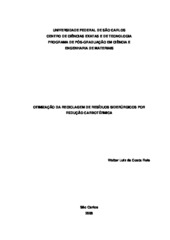| dc.contributor.author | Reis, Walter Luiz da Costa | |
| dc.date.accessioned | 2016-06-02T19:10:01Z | |
| dc.date.available | 2009-11-23 | |
| dc.date.available | 2016-06-02T19:10:01Z | |
| dc.date.issued | 2008-04-04 | |
| dc.identifier.citation | REIS, Walter Luiz da Costa. Otimização da reciclagem de resíduos siderúrgicos por
redução carbotérmica. 2008. 175 f. Tese (Doutorado em Ciências Exatas e da Terra) - Universidade Federal de São Carlos, São Carlos, 2008. | por |
| dc.identifier.uri | https://repositorio.ufscar.br/handle/ufscar/663 | |
| dc.description.abstract | The evolution of the world-wide production of steel in rates superior to 7% per year in the last five years, strongly driven by China, which got off 222,4 millions in 2003 for 489,0 million tons in 20071, leads to a strong increase in the demand of iron ore. Therefore, fine ore price of Carajás for Asia went out from 28,14 in 2003 for 73,20 US$ cents for unity of iron in 2007. An increase of 160%. These facts, when related to the layer exhaustion and the growing environmental pressures on Iron and Steel Plants of the whole world, have been taking to a series of studies to the use of the residues bearers from iron produced in these factories. Up to that time, there has not been consolidated any technology which is technically and economically viable for the recycling of these residues so far. The present work is about the usage of the blast furnace mud, the mill scale and the iron oxide produced in the pickling lines of Companhia Siderúrgica Nacional (CSN) in self reduction pellets shape. It starts the productions in scale laboratorial and industrial after the chemical and physical characterizations from these raw materials. As soon as the most appropriated formulation was defined, the production in experimental scale began. These tests were carried out in the residues palletizing pilot plant, developed by CSN. There were also tests of self reduction and of meltreduction. In the first one, the formation of a metal drop inside a hallow sphere was obtained, and in the second one a metal profit of 99,1%. In sequence, the alternatives were valued for internal recycling of these pellets. The use of the heat contained in the empty hot-metal torpedo-cars for self-reduction showed the most economical route. This technology of recycling was introduced industrially in CSN. Thus, in the present work of doctorate, it was developed an unpublished route for industrial recycling for iron and steel residues, which was technically and economically feasible. | eng |
| dc.format | application/pdf | por |
| dc.language | por | por |
| dc.publisher | Universidade Federal de São Carlos | por |
| dc.rights | Acesso Aberto | por |
| dc.subject | Siderurgia | por |
| dc.subject | Resíduos industriais reciclagem | por |
| dc.subject | Pelotas auto-redutoras | por |
| dc.subject | Alto forno | por |
| dc.subject | Lama de alto-forno | por |
| dc.subject | Siderurgy | eng |
| dc.subject | Recycling | eng |
| dc.subject | Recycling for iron | eng |
| dc.subject | Steel residues selfreduction pellets | eng |
| dc.subject | Blast furnace mud | eng |
| dc.title | Otimização da reciclagem de resíduos siderúrgicos por
redução carbotérmica | por |
| dc.type | Tese | por |
| dc.contributor.advisor1 | Silva, Elson Longo da | |
| dc.contributor.advisor1Lattes | http://lattes.cnpq.br/9848311210578810 | por |
| dc.description.resumo | O crescimento da produção mundial de aço bruto em taxas superiores a 7% ao ano nos últimos cinco anos, fortemente impulsionado pela China, que saltou de 222,4 milhões em 2003 para 489,0 milhões de toneladas em 20071, gerou um forte aumento na demanda de minério de ferro. Com isso, o preço do minério fino de Carajás para a Ásia saiu de 28,14 em 2003 para 73,20 US$ cents por unidade de ferro em 2007. Um aumento de 160%. Estes fatos, associados à exaustão das jazidas e as crescentes pressões ambientais sobre as Siderúrgicas de todo o mundo, têm levado a uma série de estudos para o aproveitamento dos resíduos portadores de ferro gerados nestas Usinas. Até então, não se consolidou nenhuma tecnologia viável técnica e economicamente para esta reciclagem. O presente trabalho trata da utilização da lama de alto-forno, da carepa de laminação e do óxido de ferro gerado nas linhas de decapagem da Companhia Siderúrgica Nacional CSN na forma de pelotas auto-redutoras. Após as caracterizações químicas e físicas destas matérias-primas, partiu-se para as produções em escala laboratorial e industrial. Definida laboratorialmente a formulação mais adequada, partiu-se para a produção experimental. Esta foi realizada na planta piloto de pelotização de resíduos, desenvolvida pela CSN. Foram realizados ensaios de auto-redução e de fusão-redução. No primeiro, o resultado foi a formação de uma gota metálica dentro de uma esfera oca e no segundo, um rendimento metálico de 99,1%. Em seqüência, foram avaliadas as alternativas para reciclagem interna destas pelotas. A utilização do calor contido nos carrostorpedo vazios para a auto-redução se mostrou como a rota mais econômica. Esta tecnologia de reciclagem já se encontra implantada industrialmente na CSN. Portanto, no presente trabalho de doutoramento, desenvolveu-se uma rota inédita de reciclagem industrial dos resíduos siderúrgicos portadores de ferro, viável técnica e economicamente. | por |
| dc.publisher.country | BR | por |
| dc.publisher.initials | UFSCar | por |
| dc.publisher.program | Programa de Pós-Graduação em Ciência e Engenharia de Materiais - PPGCEM | por |
| dc.subject.cnpq | ENGENHARIAS::ENGENHARIA DE MATERIAIS E METALURGICA | por |
| dc.contributor.authorlattes | http://lattes.cnpq.br/6346122001146622 | por |
